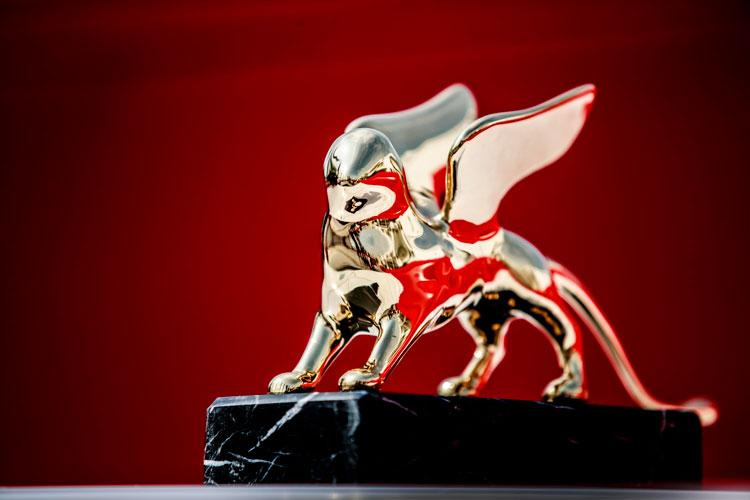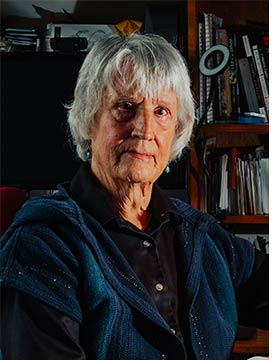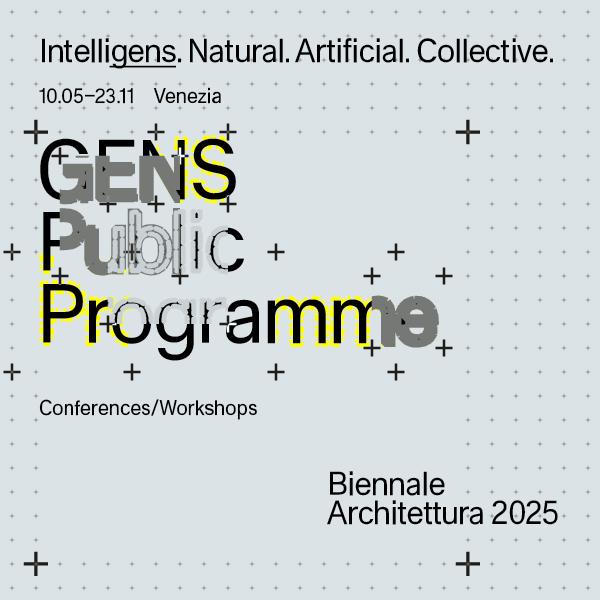
The 2025 Lion awards for Architecture
The Golden Lion for Lifetime Achievement has been awarded to the American philosopher Donna Haraway; the Special Golden Lion for Lifetime Achievement in Memoriam to the Italian architect and designer Italo Rota (1953-2024).
The awards
The American philosopher Donna Haraway and the Italian architect and designer Italo Rota (2 October 1953 – 6 April 2024) have respectively been awarded the Golden Lion for Lifetime Achievement and the Special Golden Lion for Lifetime Achievement in Memoriam of the 19th International Architecture Exhibition – La Biennale di Venezia - Intelligens. Natural. Artificial. Collective. (Giardini and Arsenale, 10 May – 23 November 2025).
The decision was approved by the Board of Directors of La Biennale chaired by Pietrangelo Buttafuoco, upon recommendation by Carlo Ratti, Curator of the 19th International Architecture Exhibition.
The awards ceremony and inauguration of Biennale Architettura 2025 will be held on Saturday 10 May at Ca’ Giustinian, the headquarters of La Biennale di Venezia. The Exhibition will open to the public on the same day at 11am.
The motivation for the awards
On the decision to award the Golden Lion for Lifetime Achievement to Donna Haraway, Carlo Ratti stated:
“Donna Haraway is one of the most influential voices in contemporary thought, straddling the social sciences, anthropology, feminist criticism, and the philosophy of technology. Over the past four decades, she has explored, in a multidisciplinary manner and with a constant capacity for linguistic invention, issues such as the impact of technological evolution on our biological nature and the ways in which the environmental context of the Chthulucene redefines the boundaries between human and nonhuman.
Haraway invented this definition - after the American writer H.P. Lovecraft - as alternative to the term “Anthropocene” (normally used to define the human impact on Earth) to emphasise the urgency of the co-existence and symbiosis with other species. From whichever route one approaches the convergence of multiple forms of intelligence in shaping our future, the legacy of Donna Haraway will appear. Her work and philosophy, radically critical but simultaneously optimistic and imaginative, are distinguished by their commitment to creating alternative worlds: to constructing positive visions in which the difficulties of the present can be overcome or mitigated through the making of new myths and the cultivation of new kin. Her contributions to the way we understand science, technology, race, gender, geography, and the environmental history of humanity have left indelible marks on the study of each, and their precedence to the notion that natural, artificial, and collective intelligences act together is self-evident. As designers grapple with a rapidly transforming present in which nature, technology, and society all present symptoms of divergence from the world as we know it, Haraway’s theory empowers us and her observations guide us. With gratitude we recognize the lifetime of visionary literature she endows to the future, and we applaud her inspirations to architecture expressed in this exhibition and far beyond”.
The Curator has motivated the choice to award the Special Golden Lion for Lifetime Achievement in Memoriam to Italo Rota as follows:
“Italo Rota was a forerunner. His vision was that of a world in which the relevance of living entities and biology in general, nature in the broadest possible definition, and finally science and applied technology were united in a single breathing entity. Throughout his life, he had the extraordinary ability to traverse the second half of the twentieth century and the first quarter of the new century by flying above the major styles and cultures of design, establishing himself as one of the most original figures in Italian and European architecture. Raised under the wing of masters such as Franco Albini, Vittorio Gregotti, and Gae Aulenti, he cultivated a unique eclecticism and a rare ability to combine poetic vision and extreme analytical lucidity. A man of boundless culture, a passionate collector and researcher of both Wunderkammer objects and technological devices, and a generous teacher, he has contributed to the creation of some of the most influential cultural venues in Europe in recent decades, with projects such as the restoration of the Musée d'Orsay in Paris and the Museo del Novecento in Milan. His cultural legacy is well expressed by the title of his last monograph, Solo diventare natura ci salverà (“Only Becoming Nature Will Save Us”) (Milan: Libri Scheiwiller, 2023)”.
“The adventure of the Biennale Architettura 2025 – Carlo Ratti added – began together with Italo Rota at the end of 2023. It was tragically interrupted with his passing a year ago, on April 6, 2024. This is why I am particularly pleased that the Board of Directors of La Biennale di Venezia accepted my proposal to award Italo with the high honor of the Special Golden Lion for Liftetime Achivement in Memoriam. Also significant is the recent decision of the Ministry of Culture - through the Soprintendenza ai Beni Archivistici e Bibliografici of Lombardy - to place a bond to attract his work to the national cultural heritage. I am equally happy, finally, to be able to present at the Arsenale the work of Margherita Palli, Italo's life and work companion, whose contribution will ideally continue our initial research.”
The Special Golden Lion for Lifetime Achievement in Memoriam will be accepted by Margherita Palli, set and costume designer, participant in the Biennale Architettura 2025 with the project Material Bank: Matters Make Sense, together with Stefano Capolongo and Ingrid Maria Paoletti (Department of Architecture, Built Environment, and Construction Engineering, Politecnico di Milano), Konstantin Novosëlov (National University of Singapore).
Previously, the Special Golden Lion for Lifetime Achievement in Memoriam of the Biennale Architettura was awarded to the Italian naturalised Brazilian architect, designer, set designer, artist and critic Lina Bo Bardi (1914-1992) at the recommendation of Hashim Sarkis, curator of the Biennale Architettura in 2021; to the Japanese architect Kazuo Shinohara (1925-2006) at the recommendation of Kazuyo Sejima, curator of the Biennale Architettura in 2010. Furthermore, the Special Golden Lion for Lifetime Achievement was awarded in 2020 to the architect Vittorio Gregotti (1927-2020), artistic director of the Visual Arts Department of La Biennale from 1975 to 1977, who in fact ushered architecture into the institution, organising many significant exhibitions in this discipline.
Biographical notes
 Donna Haraway (Denver, 6 September 1944) is a Distinguished Professor Emerita in the History of Consciousness Department at the University of California Santa Cruz (UCSC). She earned her PhD in Biology at Yale in 1972 and writes and speaks in science and technology studies, of which she explores the philosophical, political and cultural implications, with an interdisciplinary approach that intersects feminist theory and multispecies studies. She has served as thesis adviser for over 60 doctoral students in several disciplinary and interdisciplinary areas. At UCSC, she is an active participant in the Science and Justice Research Center and Center for Cultural Studies at UCSC. Attending to the intersection of biology with culture and politics, Haraway’s work explores the string figures composed by science fact, science fiction, speculative feminism, speculative fabulation, science and technology studies, and multispecies worlding.
Donna Haraway (Denver, 6 September 1944) is a Distinguished Professor Emerita in the History of Consciousness Department at the University of California Santa Cruz (UCSC). She earned her PhD in Biology at Yale in 1972 and writes and speaks in science and technology studies, of which she explores the philosophical, political and cultural implications, with an interdisciplinary approach that intersects feminist theory and multispecies studies. She has served as thesis adviser for over 60 doctoral students in several disciplinary and interdisciplinary areas. At UCSC, she is an active participant in the Science and Justice Research Center and Center for Cultural Studies at UCSC. Attending to the intersection of biology with culture and politics, Haraway’s work explores the string figures composed by science fact, science fiction, speculative feminism, speculative fabulation, science and technology studies, and multispecies worlding.
Her most prominent books include: Staying with the Trouble: Making Kin in the Chthulucene, Duke University Press (2016); Manifestly Haraway, University of Minnesota Press (2016); When Species Meet, University of Minnesota Press (2008); The Haraway Reader, Routledge (2004); The Companion Species Manifesto: Dogs, People, and Significant Otherness, Prickly Paradigm Press (2003); Modest_Witness@Second_Millennium, Routledge (1997, 2018); Simians, Cyborgs, and Women, Routledge (1991); Primate Visions. Gender, Race, and Nature in the World of Modern Science, Routledge (1989); and Crystals, Fabrics, and Fields: Metaphors of Organicism in Twentieth-Century Developmental Biology, Northwestern University Press (1976, 2004).
Two film productions have been dedicated to the philosopher’s work: Donna Haraway: Story Telling for Earthly Survival (2016), a documentary film directed by Fabrizio Terranova, and Camille & Ulysse (2021), a film directed by Diana Toucedo, with Haraway and Vinciane Despret. With Adele Clarke she co-edited Making Kin Not Population (Prickly Paradigm Press, 2018), which addresses questions of human numbers, feminist anti-racist reproductive and environmental justice, and multispecies flourishing.
 The architectural and design work of Italo Rota (Milan, 2 October 1953 – Milan, 6 April 2024) was centred for over thirty years on constant and advanced cross-disciplinary research, from contemporary art to robotics, to develop innovative projects in which humanistic beauty and sustainability became integral and disruptive elements.
The architectural and design work of Italo Rota (Milan, 2 October 1953 – Milan, 6 April 2024) was centred for over thirty years on constant and advanced cross-disciplinary research, from contemporary art to robotics, to develop innovative projects in which humanistic beauty and sustainability became integral and disruptive elements.
Rota graduated from the Politecnico di Milano and worked for many years with Vittorio Gregotti and Franco Albini. In the early 1980s, with Gae Aulenti and Piero Castiglioni, he won the competition to design the interior spaces of the Musée d’Orsay; he moved to Paris, and there, with Gae Aulenti, he designed the project to renovate the Modern Art Museum at the Centre Pompidou. He opened his own firm in the French capital, and designed the French School exhibition rooms in the Louvre’s Cour Carré, the lighting for Notre-Dame Cathedral and the bank of the Seine River, the renovation of the city centre in Nantes.
In the early 1990s, he returned definitively to Milan where he developed design projects and architectural works in Italy and around the world, which include: the renovation of the Civic Museums in Reggio Emilia, the new Elatech Robot Factory in Brembilla, the great Teatro dei Bambini in Maciachini in Milan, the new Noosphere Laboratory Pavilion at the Triennale di Milano, the EXPO Milano 2015 Pavilions for Kuwait, Italian Wine and the Arts and Foods Pavilion.
With the project for the Italian Pavilion at Expo Dubai 2020, Rota began a collaboration with the Studio Carlo Ratti, which continued with many projects through his death. Works that symbolise his poetics include the Museo del Novecento in Piazza Duomo in Milan, the Centre for Post-Graduate Studies at Columbia University in New York and the Hindu Temple at Dolvy in India.
He was responsible for countless exhibitions in major Museums as well as publications, installations and pavilions, including the thematic Central Pavilion for Expo Zaragoza 2008. His work was presented within the Italian Pavilion in many editions of the International Architecture Exhibition of La Biennale di Venezia: Innesti/Grafting, curated by Cino Zucchi, with Studio Italo Rota & Partners (Biennale Architettura 2014, curated by Rem Koolhaas); Ailati. Reflections from the Future, curated by Luca Molinari, with Studio Italo Rota & Partners (Biennale Architettura 2010, curated by Kazuyo Sejima); L’Italia cerca casa, curated by Francesco Garofalo (Biennale Architettura 2008, curated by Aaron Betsky).
He served as the Scientific Director of NABA, Nuova Accademia di Belle Arti in Milan; as Professor at Shanghai Wusong International Art City Shanghai Academy of Fine Art; and Advisor at Tsinghua University in Beijing.
He won many acknowledgments, including the Gold Medal of Italian Architecture for public spaces, the Gold Medal of Italian Architecture for culture and leisure, the Landmark Conservancy Prize in New York and the Grand Prix de l’Urbanisme in Paris.
On 2 November 2024 his name was added to the Famedio di Milano, the Temple of Fame at the Monumental Cemetery.




